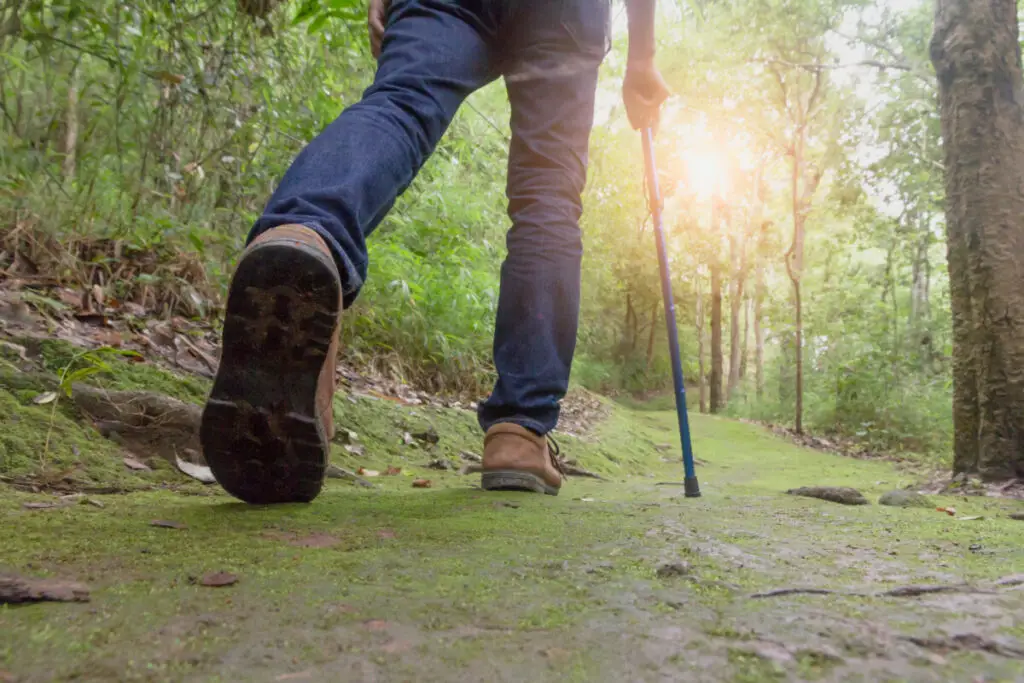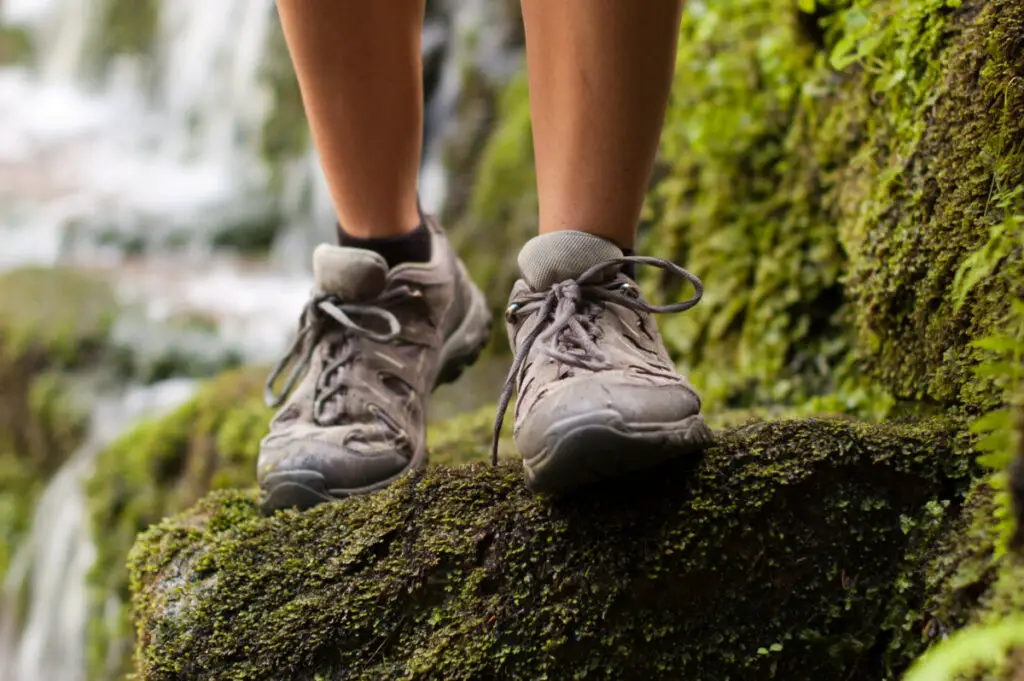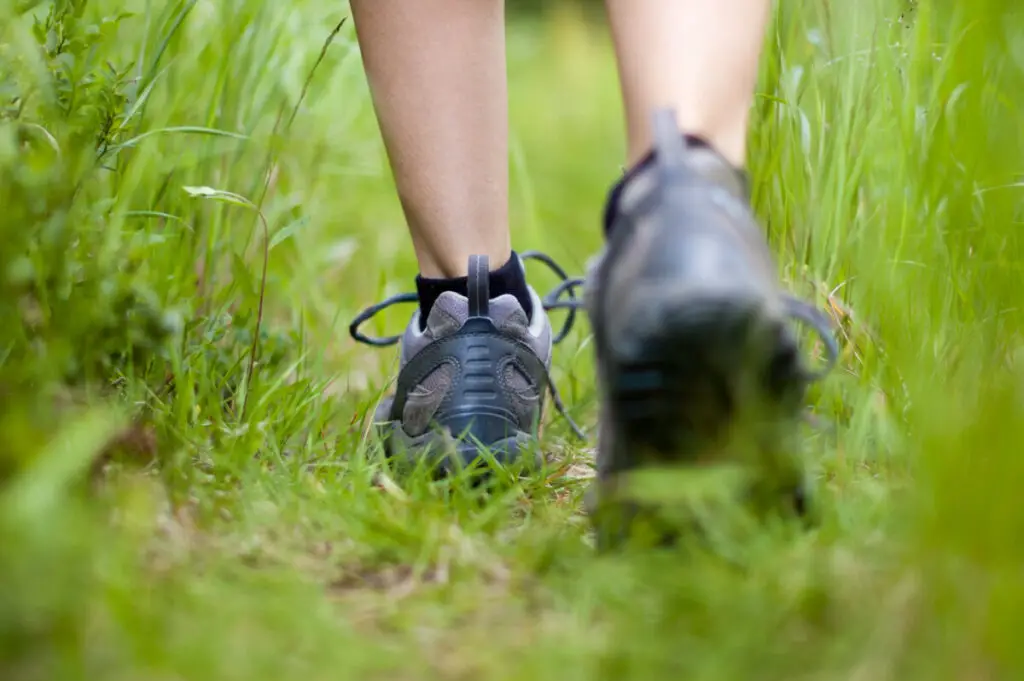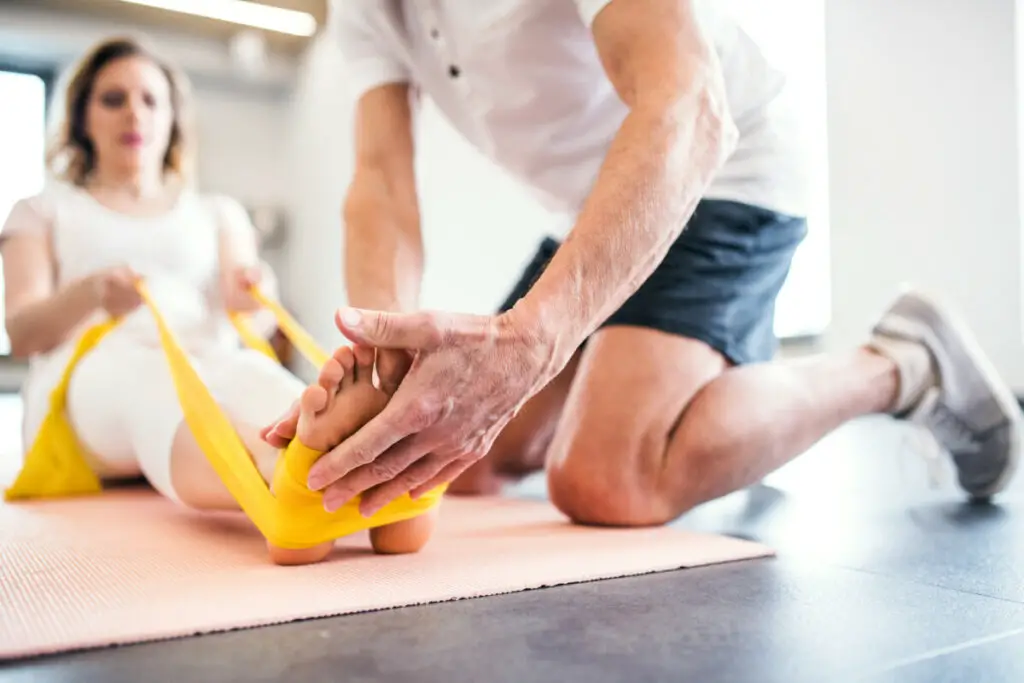
Hiking is great, but a sprained ankle can turn a good day into a bad one in less time than it takes to say “oops.” Can the right hiking boots help prevent sprained ankles?
The best hiking boots for bad ankles will be something fitted to the hiker by professionals. Priority should be placed on good orthotics for arch support and a strong base on the shoe. Most hikers with bad ankles prefer wearing hiking sandals or sneakers to build ankle strength.
Good hiking boots can protect weak ankles from scrapes, rocks, and bites, but successful hikes depend on getting the right shoe for your foot. Keep reading below for more info on buying the right hiking boot for you!
Bad Ankles and Hiking Boots
The answer to this question might not be quite what you expect. The best boots for weak ankles might not be boots at all. In fact, most hikers with weak ankles or a history of sprains suggest ditching the boots in favor of sneakers or hiking sandals.
The Best Boots Might Not Be Boots
There are good hiking boots for ankle support, but over 97% of hikers in multiple online hiking forums (such as r/Ultralight, r/CampingGear, and r/coloradohikers) agreed that it is better to strengthen your ankles over time than to give them artificial support through a boot. Getting the wrong boot may feel better in the short term, but it can seriously harm your ankles over time by allowing the muscles and tendons to weaken.
Instead, these hikers and their doctors suggested getting good-quality boots, sneakers, or sandals that put the emphasis on supporting the foot itself. Proper arch support, good grip, and even custom orthotics do more for a weak ankle’s long-term health than a heavily structured boot ever could.
Who Needs Supportive Hiking Boots?
Some people are not able to strengthen their ankles. Disabilities like Ehlers Danlos Syndrome, physical damage to or gaps in the muscle, or other conditions of this sort could mean that artificial ankle support is preferable to hiking in less structured boots. Consult with your doctor when making this decision.
For people in this situation, a top piece of advice was to go into a professional hiking boot outfitter and get a consultation. Major chains like REI can provide this service, and many cities also have specialty shoe stores that can help you try on and test out a variety of hiking boots until you find the boot for you.
What Are Some Good Examples of Alternatives to Hiking Boots?
Trail runners are the top-recommended alternative to hiking boots for anyone who wants to improve their ankle health. These shoes are made for a varied stride, using similar trails to what you’d hike on, so they allow you to move your ankle freely while still protecting your foot from the dangers of a trail. You can use them to build up ankle strength on short hikes until you feel ready to tackle bigger challenges.
If you’re at the very beginning of your journey to stronger ankles, many experienced hikers would also suggest basic sturdy tennis shoes on mild trails until you feel more confident and secure. This can be a cheaper option for somebody getting back into hiking or just starting out.
The Best Hiking Boots for Bad Ankles

When it comes to the best hiking boots for bad ankles, keep in mind that the answer may be counterintuitive. Something with too much structure and support in the ankle can lead to more problems later on when your ankle muscles weaken. Consult with your doctor or footwear professionals to see which of these options is best for you.
Remember that the best shoe for one person is not the best shoe for everyone. Thin feet, wide feet, short or long feet, and different arch shapes will all impact how a shoe fits you. If you have any kind of foot or ankle problem, it is imperative that you try the shoe on in person instead of buying online. Getting the wrong hiking boot can land you in more pain than you started with, along with increasing the risk of getting another sprain or new knee issues.
Best Hiking Boots with Extra Ankle Support
Of all the hiking boots that were actually recommended by the sprained-ankle club, there’s no question that the Salomon Quest line is the most beloved. They’re sturdy, water-resistant, have great support for your foot as well as your ankle, adapt well to professional orthotics, and their laces are secure. The downside is that they can be overkill for mild trails, and it’s easy to get used to the support and stop strengthening your ankles.
The LOWA Renegade is the next popular boot, staying close in competition with the Salomon hiking line. LOWA Renegades offer serious foot and ankle support, stability, durability, and traction to keep you from unpleasant slips, but aren’t quite as hardcore as the Salomon boots. This can be good for people who aren’t going to trek across Patagonia quite yet, and who want some nice ankle support as they traverse their local trails. They pair well with whatever insole you’d like to use, which is another great feature for anyone who wants lasting support for joint health.
Best Hiking Boots as Recommended by Hikers Strengthening Their Ankles
While technically these can be called hiking shoes rather than hiking boots, they’re similar in all ways except for ankle height. For hikers focusing on strengthening their ankles, this is preferred.
Salomon made another hit with the Salomon OUTline Low GTX hiking shoes. They’re stable, fit securely, and offer great traction to reassure hikers. If you’re worried about spraining an ankle, these will give you the help you need to stay safe while you build up the strength and motility you need. The only thing you might miss from mid-rise or high-rise hiking boots is the protection from sticks on the trail, but being able to improve motility is a good trade-off.
Columbia Facet 60 Outdry is the next good hiking shoe, though they’re definitely a little more casual than anything made by Salomon. One of the best features of these shoes, though it can be regarded as a negative by some people, is that they are wide. Even the normal size is very wide. For those of us with tree trunks for ankles who just can’t manage a normal boot, but who still want to build up ankle strength, this is a fantastic feature. If you don’t have wide feet, you might struggle to lace them tightly enough, but if you do have wide feet, you’ll fall in love.
La Sportiva Spire GTX is another waterproof, sturdy, all-around great hiking shoe that is easy to recommend. They’re burly, well-built, and as ready for your next backpacking adventure as a hiking shoe can get. The downside is that they can be a little too intense for more casual hikers, and they run at a higher price than many other hiking shoes or trail runners.
Top Recommended Alternatives to Hiking Boots

Hiking boots are good, or even great for many people, but an increasing number of people are moving away from heavy, burly, overkill hiking boots and towards the much more manageable hiking shoes or trail runners. Too much support in a hiking boot was hurting hikers in the long term, taking away ankle strength and motility and leaving hikers vulnerable to a sprain.
In addition to this, many hikers with bad ankles should not be starting on intense trails until after they’ve built up strength. If you believe that you need a heavy-duty boot while you’re hiking across the world, experienced hikers would say that you should delay that big trip and spend a few months on lighter trails first. This will give you a chance to build up those ankles before you’re in a potentially dangerous situation.
With this history in mind, here are some of the most popular alternatives to hiking boots as voted by hikers on forums across the internet.
Trail Runners and Hiking Shoes
Trail Runners and Hiking Shoes share many of the benefits of hiking boots, like waterproof fabric and great traction, without potentially weakening your ankles. They’re ideal for the more casual trails that you should be using while rebuilding ankle strength and health. Any trail that would be too much for these shoes to handle would also be dangerous for bad ankles to travel on.
More importantly, these shoes are actually designed to help support your ankles, knees, and hips in a functional way. Even if they don’t feel like an ankle brace, they’re doing more for you than a brace could. Good hiking shoes and orthotics will keep you in alignment as you walk and hike, allowing you to learn balance and new reactions to risky steps.
Classic Tennis Shoes or Sneakers
If you’re keeping things very casual, relearning how to hike by walking on well-established trails that are also friendly to small children is actually a very smart decision. You can strengthen weak ankles without worrying about a fall in an isolated location.
Many people in this situation don’t want to spend money on hiking shoes right away. They want to learn how to move again, make mistakes, adjust slowly, and make that journey in shoes that cost $25-$50 instead of $140. This line of reasoning is completely fair and, once again, can actually be a very smart decision. After all, the goal is to get you back into hiking for the long term, right?
This is another alternative that is backed by experienced hikers. As many hikers transitioned from hiking boots to hiking shoes and discovered how weak their ankles were, they went back to classic athletic shoes to help them build their strength back.
Barefoot Hiking Shoes or Boots
This option definitely isn’t for everyone, but there are people around the world who swear by taking short hikes in “barefoot” shoes. The shoes allow hikers to connect with their surroundings, feel the trail, and become more aware of how each step will impact them.
If you discover that your propensity for sprains has more to do with proprioception than joint health, this could actually be the best solution for you. Barefoot shoes help you become aware of where you are in space, and they can also help build up strength in the foot as well as the ankle. In theory, this will help you avoid sprains in the rest of your day as much as it will help you avoid them when hiking.
The downsides of barefoot shoes include vulnerability to hazards like broken glass or sharp rocks, as well as the longer learning curve as you grow callouses on your feet, and they do not function well with orthotics.
How to Adjust to Hiking without Heavy Ankle Support

There are a few simple things that can help you adjust to hiking with low to medium support directly on your ankle, allowing you to branch out into boots that are authentically good for you.
Custom Orthotics or Insoles
Anyone who has experienced well-made and correctly fitted insoles can tell you what a weird experience it is.
First, it might hurt for a few days. The insoles or orthotics correct your ankle posture, then your knees, then your hips, and it goes all the way up your back and neck. Joints you didn’t know existed might start popping as everything re-aligns. The worse your ankles and arches, the more dramatic the results.
Once things are where they’re supposed to be, you’ll get to start retraining your ankles to handle things like hiking. Sneakers or trail runners work just fine when your ankle isn’t naturally rolling all the time because of weak arches. You might be sorer than you’d expect, but that’s a good thing when muscles are working.
If your ankles tilt in, you have weird arches, or your knees touch when you’re standing, try getting custom insoles and work from there.
Physical Therapy and Training
Really bad ankles are a medical problem. If you’re vulnerable to sprains, you have constant pain, or any other issue like this, get professional help before trying to self-treat with braces or overkill boots. Don’t do long-term damage when you might just need a new set of exercises.
Go Walking and Hiking in Less Intense Boots
You might find that the problem has been overprotective boots all along. If you’re never able to build ankle strength, then you’ll never have ankle strength. Try out some of the ideas from this article on your next hike, take it easy, and get those muscles going.

